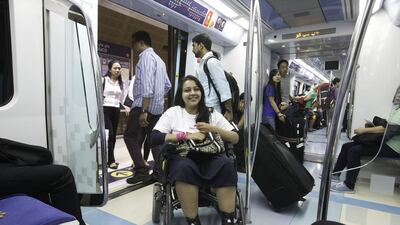DUBAI // Shobhika Kalra rides the metro every day from her home in Rashidiya to study at the American University in Dubai, in Dubai Media City.
But unlike many other students and Dubai Metro users, the 24-year-old has been confined to a wheelchair for the past 10 years due to a degenerative disease.
Her condition, Friedreich’s ataxia, is a rare, inherited degenerative disorder that damages the nervous system and affects the muscles and heart. Undeterred, Ms Kalra relies on the metro to take her to study, visit malls and meet friends.
“The metro is nice and I enjoy using it because it has made me more mobile and independent,” said the undergraduate Business Administration student. “The staff are very helpful.”
However, it has been a bumpy ride for Ms Karla, who has been campaigning for more wheelchair ramps outside the stations through her group, Wings of Angelz.
“There are ramps in the platforms but there are no ramps on the roads to get inside or leave the stations. How do you go to other places if there are no ramps?” she asked. Since the launch of the metro in 2009, Ms Karla and her sister, Ruchika, have been campaigning for more outside ramps.
After meeting with Roads and Transport Authority officials and pushing for her cause for the past five years, the sisters finally achieved some success last month. Ramps were installed outside the Rashidiya and Emirates stations.
“I met with the right officials and they were very helpful. In three weeks, they put up these ramps. But there are many more stations without them. Sometimes the ramps are at entrances that are far and can take about 30 minutes to reach. It’s the same at the Nakheel station, near my university. There are no ramps on the side facing the university. I have to go all the way around.
“We had written lots of complaints to the RTA. It’s taken so many years but I’m thankful it has been done. I hope to campaign harder and make them all more wheelchair friendly.”
Wings of Angelz encourages people with disabilities to take photos of places without ramps or wheelchair access and then the sisters will take over to request changes.
Their work is not confined to the UAE but extends their hometown of Bhopal, where they have ensured better wheelchair access in several places.
However, the RTA said it had put in many features.
Mattar Al Tayer, chairman of the board and executive director of the RTA, said there were tactile paths to assist visually impaired persons from the entrance to the station platform. He said they had also put up wide, automated fare collection gates, lowered ticketing gates, toilets with ergonomic grab rails and emergency call buttons at a height accessible for wheelchair users.
“There is designated space for a wheelchair in each carriage, located close to the door, as well as dedicated areas for people with special needs in each car,” said Mr Al Tayer.
pkannan@thenational.ae

